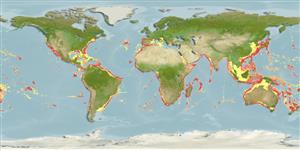分类 / Names
俗名 | 同种异名 | Catalog of Fishes(属, 种) | ITIS | CoL | WoRMS | Cloffa
Teleostei >
Beryciformes (Sawbellies) >
Berycidae (Alfonsinos)
Etymology: Beryx: Greek, beryx or berys = a name of a fish. Cuvier & Valenciennes (1829:221) precise that the name was used by Gesner from Varinus, but with no indication whatsoever helping identifying any species. After D'Arcy Wentworth Thompson (A glossary of Greek fishes, 1947), the name actually seems to come originally from Hesychius, but perhaps the name was not originally a fish name. Thompson compares it to meryx (ruminant), applied on skaros (Scarus), so it may have been applied on a parrot fish referring to its browsing/grazing behavior described by Aristoteles and followers..
More on author: Lowe.
Environment: milieu / climate zone / depth range / distribution range
生态学
海洋 底中水层性; 深度上下限 25 - 1300 m (Ref. 9833), usually 400 - 600 m (Ref. 27121). 亞熱帶的; 45°N - 43°S, 180°W - 180°E
Circumglobal, excluding the northeast Pacific and Mediterranean Sea (Ref. 9833). Western Atlantic: Gulf of Maine to the Gulf of Mexico (Ref. 6743). Eastern Atlantic: off southwestern Europe and the Canary Islands (Ref. 7413) to South Africa (Ref. 4179). Indo-Pacific: East Africa (including Saya de Malha Bank, Ref. 33390) to Japan, Hawaii, Australia, and New Zealand (Ref. 5755). The limited number of records in the western Pacific is doubtless the result of limited fishing effort below 200 m (Ref. 9833). Eastern Pacific: Chile (Ref. 27363).
Circumglobal ,除了東北太平洋與地中海.(參考文獻 9833) 西大西洋: 緬因灣到墨西哥灣.(參考文獻 6743) 東大西洋: 外海的歐洲西南方與加納利群島 (參考文獻 7413) 到南非.(參考文獻 4179) 印度-太平洋: 東非 (包括 Saya de Malha 岸堤, 參考文獻 33390) 至日本,夏威夷,澳洲與紐西蘭.(參考文獻 5755) 在西太平洋的有限的數目紀錄在 200 公尺之下無疑地是限制魚撈的結果。 (參考文獻 9833) 東太平洋: 智利.(參考文獻 27363)
Length at first maturity / 大小 / 重量 / 年龄
Maturity: Lm 33.2 range ? - ? cm
Max length : 70.0 cm TL 雄鱼/尚未辨别雌雄; (Ref. 30573); common length : 40.0 cm TL 雄鱼/尚未辨别雌雄; (Ref. 30573); 最大体重: 4.0 kg (Ref. 43448); 最大年龄: 23 年 (Ref. 35874)
背棘 (总数) : 4; 背的软条 (总数) : 13 - 16; 臀棘: 4; 臀鳍软条: 26 - 30. First infraorbital bone with a spine projecting laterally on anterior end. Lateral line extends to caudal fin. A fleshy disk on inner face of exposed area of scale. In young fishes, the 2nd dorsal ray is elongate (Ref. 559). Ref. 27363 notes pectoral fins with one spine and 17 soft rays (Ref. 27363).
第一个眶下骨有一根棘突出的侧面地在前端上。 侧线延伸到尾鳍。 在鳞片的裸露区域的内面上的一个肉质的圆盘。 在幼鱼中,第二背鳍鳍条是延长。 (参考文献 559) 参考文献 27363个附注胸鳍有一根棘与 17个软鳍条。 (参考文献 27363)
Adults inhabit the outer shelf (180 m) and slope to at least 1,300 m depth, probably moving further from the bottom at night; often found over seamounts (Ref. 9833) and underwater ridges (Ref. 33648). Juveniles pelagic (Ref. 9072). Feed mainly on fish, crustaceans and cephalopods (Ref. 33648). Oviparous, spawn in batches (Ref. 30291). Eggs and larvae are pelagic (Ref. 30291). Marketed frozen and eaten steamed, fried, broiled, boiled, microwaved and baked (Ref. 9988).
栖息于外部的大陆架 (180 公尺) 与斜坡到至少 1,300 公尺深, 可能从底部移动进一步在晚上; 时常发现在海洋山脊 (参考文献 9833) 与在水中的脊上面了。 (参考文献 33648) 稚鱼是大洋性的。 (参考文献 9072) 主要吃鱼,甲壳动物与头足类动物。 (参考文献 33648) 在市场上冷冻销售而且清蒸了, 油炸了, 火烤了, 煮沸了, 微波了而且烧烤了。 (参考文献 9988)
Spawning occurs about 10 to 12 times at intervals of about 4 days during the breeding season (Ref. 58433).Circumglobal ,除了東北太平洋與地中海.(參考文獻 9833) 西大西洋: 緬因灣到墨西哥灣.(參考文獻 6743) 東大西洋: 外海的歐洲西南方與加納利群島 (參考文獻 7413) 到南非.(參考文獻 4179) 印度-太平洋: 東非 (包括 Saya de Malha 岸堤, 參考文獻 33390) 至日本,夏威夷,澳洲與紐西蘭.(參考文獻 5755) 在西太平洋的有限的數目紀錄在 200 公尺之下無疑地是限制魚撈的結果。 (參考文獻 9833) 東太平洋: 智利.(參考文獻 27363)
Maul, G.E., 1990. Berycidae. p. 626. In J.C. Quero, J.C. Hureau, C. Karrer, A. Post and L. Saldanha (eds.) Check-list of the fishes of the eastern tropical Atlantic (CLOFETA). JNICT, Lisbon; SEI, Paris; and UNESCO, Paris. Vol. 2. (Ref. 7413)
人类利用
渔业: 商业性
工具
特别资料
下载 XML
网络资源
Estimates based on models
Preferred temperature (Ref.
123201): 6.6 - 12.9, mean 9.2 °C (based on 569 cells).
Phylogenetic diversity index (Ref.
82804): PD
50 = 0.6260 [Uniqueness, from 0.5 = low to 2.0 = high].
Bayesian length-weight: a=0.01514 (0.01153 - 0.01986), b=3.05 (2.97 - 3.13), in cm total length, based on LWR estimates for this species (Ref.
93245).
营养阶层 (Ref.
69278): 4.3 ±0.2 se; based on diet studies.
Generation time: 7.5 (6.2 - 8.3) years. Estimated as median ln(3)/K based on 15
growth studies.
回复力 (Ref.
120179): 低的, 最小族群倍增时间4.5 - 14 年 (K=0.10-0.18; tm=5-7.5; tmax=23; Fec = 270,000).
Prior r = 0.28, 95% CL = 0.19 - 0.42, Based on 1 data-limited stock assessment.
Fishing Vulnerability (Ref.
59153): High vulnerability (59 of 100).
Climate Vulnerability (Ref.
125649): High vulnerability (58 of 100).
Nutrients (Ref.
124155): Calcium = 30.7 [9.0, 106.2] mg/100g; Iron = 0.746 [0.364, 1.431] mg/100g; Protein = 17.8 [16.7, 19.0] %; Omega3 = 0.472 [0.193, 1.101] g/100g; Selenium = 52.9 [26.3, 104.7] μg/100g; VitaminA = 26.8 [9.1, 86.8] μg/100g; Zinc = 0.553 [0.382, 0.825] mg/100g (wet weight);
